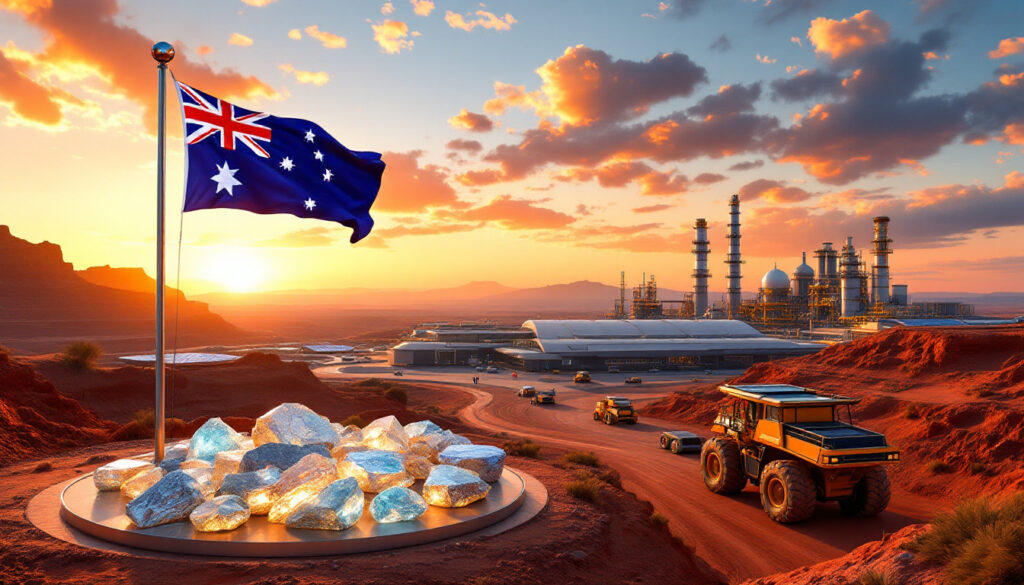What Are Labor's Mining Tax Sweeteners?
Labor's production tax credits, announced in the 2024 federal budget, represent a significant policy shift designed to boost Australia's critical minerals sector. The credits offer financial incentives equivalent to 10% of processing costs for lithium, cobalt, nickel, and other minerals essential to the clean energy revolution and advanced manufacturing.
Developed through extensive consultation with the Western Australia Chamber of Minerals and Energy and the Association of Mining and Exploration Companies (AMEC), these tax incentives aim to address a crucial gap in Australia's resource economy—the lack of domestic processing capability.
"Australia has always been excellent at digging things out of the ground, but we've historically missed opportunities to capture value further up the supply chain," explains Warren Pearce, CEO of AMEC. "These production tax credits will help us compete with heavily subsidized operations in China and elsewhere."
The policy specifically targets critical minerals processing, where Australia currently refines just 7% of the raw materials it mines, with most processing occurring offshore in China. By providing a 10% non-refundable tax offset for eligible critical minerals projects, the government projects an additional $7.4 billion in private investment by 2030.
Key Benefits for the Mining Industry
Labor's mining tax sweetener delivers multiple advantages for Australia's $390 billion resources sector. Most significantly, they improve cost competitiveness against Chinese suppliers, who benefit from state subsidies estimated at 15-20% of operational costs according to the International Energy Agency.
"What many people don't realize is that Australia is fighting an uphill battle against Chinese processors who receive subsidized electricity, preferential financing, and direct government support," notes resources economist Dr. Helena Wong. "The production tax credits help level what has been a deliberately tilted playing field."
Beyond immediate competitiveness, the credits support Australia's sovereign capability in critical minerals processing. This carries strategic importance as global supply chains face increasing geopolitical market strategies and demand for battery minerals is projected to increase six-fold by 2040.
The policy also encourages investment in regional processing hubs, with the potential to create an estimated 14,800 jobs in areas like the Pilbara, Kalgoorlie, and Townsville—regions that have traditionally exported raw materials without capturing downstream value.
Why Is There Political Division Over the Mining Tax Credits?
Coalition Opposition Stance
Despite broad industry support, the production tax credits have faced significant opposition from the Coalition. Shadow Treasury spokesperson Angus Taylor has characterized the policy as "billions for billionaires," suggesting it represents corporate welfare rather than sound economic policy.
"We have a government that thinks the answer to every problem is to spend more taxpayer money," Taylor stated during parliamentary debate. "These credits will cost $4.2 billion over the forward estimates, with 73% of benefits flowing to large multinational corporations according to Treasury modeling."
The Coalition's formal position against the policy has created tension within its ranks, particularly among members representing resource-rich states. Opposition Leader Peter Dutton appeared to soften his stance when addressing mining executives at the Western Australian "Dealers and Diggers" industry conference, only to reaffirm opposition days later.
This ambivalence reflects deeper ideological divisions within conservative politics between free-market principles and industrial policy interventions. Some Liberal MPs privately acknowledge the policy's merits but remain bound by party positions.
"There's an understanding that Australia needs to compete in critical minerals, but fiscal conservatives are wary of market intervention," explains political analyst Dr. James Robertson. "It's created what we might call a 'resources wedge' within the Coalition."
Support from Industry and Some Politicians
The tax credits successfully passed into law with support from the Greens and key crossbenchers, who viewed the policy through a sovereignty and climate transition lens rather than purely economic terms.
Warren Pearce of AMEC has indicated there is "broader support for the measure than public positioning might suggest," noting that private conversations with parliamentarians across the political spectrum reveal pragmatic recognition of the policy's necessity.
Mining companies have unequivocally welcomed the tax credits. Mineral Resources CEO Chris Ellison called them "essential for maintaining Australia's competitive edge," while Lynas Rare Earths' Amanda Lacaze praised the policy for "recognizing the strategic importance of onshore processing capability."
What's particularly notable is the policy's ability to unite typically opposed stakeholders. Environmental groups have cautiously supported the measure as necessary for renewable energy supply chains, while national security experts emphasize the strategic imperative of reducing dependence on Chinese processing.
How Is This Affecting the Federal Election Campaign?
The Bullwinkel Battleground
The newly created semi-rural seat of Bullwinkel in Western Australia has emerged as a fascinating test case for how the mining tax credits debate is influencing electoral politics. Named after the former mine manager and World War II hero Leslie Bullwinkel, the electorate encompasses significant mining operations and communities economically dependent on the resources sector.
In this three-way contest, WA Nationals candidate Mia Davies has made headlines by publicly breaking with the federal Coalition's position. During a campaign event in Kalgoorlie, Davies stated: "I'm disappointed that my federal colleagues aren't backing the West Australian resources sector on this issue. Good policy deserves support regardless of which side proposes it."
Internal polling suggests Davies' stance resonates with local voters, with 67% of Bullwinkel residents supporting the tax credits according to a Chamber of Minerals and Energy survey. This presents a challenge for Liberal candidate Matt Moran, who must navigate between local sentiment and federal party messaging.
Labor's mining tax sweetener has been capitalized on by the party, with their candidate emphasizing how the tax credits will generate an estimated 3,200 jobs directly within the electorate. Campaign materials highlight specific projects already announced in response to the policy, including a $780 million lithium hydroxide facility expected to create 740 permanent positions.
Mia Davies' Position on the Policy
Davies brings significant political credibility to her stance, having served as WA Nationals leader and state opposition leader from 2021 to 2023. Her willingness to publicly criticize the Coalition's position reflects both her independence and the economic realities of Western Australia.
"I have no qualms about saying what I think is good policy over politics," Davies told reporters. "The production tax credits are vital for Western Australia's future, and I'll never take a backward step when it comes to standing up for our resources sector."
Her position emphasizes that the tax credits aren't merely about corporate profits but about maintaining Australia's competitive advantage in an increasingly strategic industry. Davies points to geological analysis showing Australia possesses 21% of global lithium reserves but captures only 6% of the refined product value—a gap the tax credits aim to address.
This stance has created an unusual dynamic where a National Party candidate is aligned with Labor policy, highlighting how resource politics can transcend traditional partisan boundaries. Political analysts suggest this reflects the distinctive nature of Western Australian politics, where state interests often override federal party allegiances.
What Impact Will This Have on Australia's Mining Future?
Strategic Importance for Critical Minerals
The production tax credits arrive at a pivotal moment for Australia's mining sector. Global demand for critical minerals is forecast to increase dramatically, with lithium demand alone projected to rise 450% by 2050 according to the International Energy Agency.
Australia currently supplies 55% of the world's lithium, 29% of rare earth elements, and significant quantities of cobalt, graphite, and manganese—all essential inputs for clean energy technologies. However, the country captures a disproportionately small share of the processing value.
"What few people understand is the magnitude of the economic opportunity," explains mining analyst Sarah Johnston. "Australia earns approximately $40,000 per tonne exporting raw lithium concentrate, but refined lithium hydroxide commands $78,000 per tonne. The tax credits help bridge the investment gap to capture that value difference."
The policy also addresses vulnerabilities in global supply chains exposed during recent China's export restrictions. China currently controls 87% of rare earth processing, 65% of lithium refining, and 73% of cobalt refining globally—creating strategic concerns for Western economies transitioning to clean energy.
By incentivizing domestic processing, Australia aims to position itself as a trusted supplier to allied nations seeking to diversify critical mineral shortages sources. Recent agreements with Japan, South Korea, and the European Union highlight the diplomatic significance of this capability.
Industry Confidence in the Policy
AMEC and other industry groups have expressed strong confidence that the tax credits will remain regardless of election outcomes. Warren Pearce emphasized this point, noting: "The strategic imperative transcends party politics. We've had constructive discussions with members across parliament who recognize the necessity of this policy for Australia's economic future."
This confidence has already translated into investment decisions. Since the announcement of the tax credits, companies have accelerated plans for fourteen new processing facilities across Australia. Notable examples include Albemarle's expansion of its Kemerton lithium processing facility and Iluka Resources' rare earths refinery in Western Australia.
Industry leaders cite the predictability of the tax credits as particularly valuable. Unlike grant programs that require case-by-case government approval, the credits provide certainty for long-term capital allocation decisions. This addresses a key barrier to investment in processing facilities, which typically require 7-10 years to reach full operational capacity.
Minerals Council of Australia analysis indicates the credits could help Australia increase its share of global critical minerals processing from 7% to 24% by 2035, representing an additional $27 billion in annual economic activity. While ambitious, this projection reflects the transformative potential of the policy if it remains stable across electoral cycles and aligns with broader mining industry predictions.
FAQ: Labor's Mining Tax Sweetener
What exactly are production tax credits?
Production tax credits are financial incentives provided as non-refundable tax offsets equivalent to 10% of eligible expenditure on critical minerals processing. They apply specifically to processing activities that transform raw minerals into refined products, such as converting spodumene concentrate into battery-grade lithium hydroxide or producing rare earth oxides from mineral concentrates.
Why does the mining industry support these tax credits?
The industry views these credits as essential for overcoming the significant cost disadvantages Australian processors face compared to international competitors. Mining companies estimate that electricity costs in Australia are 40-60% higher than in China, while labor costs can be 3-4 times greater. The credits help bridge this gap while encouraging the development of more efficient processing technologies suited to Australian conditions.
Why is there opposition to the policy within the Coalition?
Opposition stems from several factors, including fiscal concerns about the $4.2 billion cost, philosophical objections to market intervention, and political calculations about targeting government spending. Some Coalition members argue the funding could be better directed toward broader tax relief or infrastructure projects benefiting a wider range of industries rather than targeting specific sectors.
How might this policy affect Australia's critical minerals strategy?
The policy represents a shift from Australia's traditional role as a supplier of raw materials to a more integrated position in global supply chains. By incentivizing domestic processing, Australia aims to capture more economic value while strengthening relationships with key technology manufacturing nations. The strategy also supports broader goals of creating advanced manufacturing capabilities adjacent to mineral processing facilities.
Will the policy survive regardless of who wins the election?
Industry opinion suggests the fundamentals driving the policy—strategic concerns about supply chain resilience, economic incentives for value-adding, and geopolitical positioning—transcend partisan politics. While implementation details might change, the core concept of supporting domestic critical minerals processing appears to have sufficient cross-party support to remain in some form regardless of electoral outcomes.
Ready to Capitalise on Australia's Critical Minerals Future?
Discover how you can stay ahead of major mineral discoveries and transformative policies like Labor's mining tax sweeteners with real-time alerts from Discovery Alert's proprietary Discovery IQ model, turning complex mineral data into actionable insights. Explore historic discoveries that have generated substantial returns by visiting Discovery Alert's dedicated discoveries page and position yourself ahead of the market.




